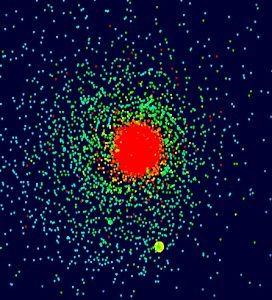
If the collision hypothesis about the formation of the Moon is correct, why is there no ring of debris around Earth? Surely the residual debris were not all swept up by the gravity of the Earth and the Moon.
The collision hypothesis for the formation of the Moon (also known as the Giant Impact hypothesis) is certainly the leading contender to explain the so-called Earth-Moon system. Strictly speaking, we do not know if it is one-hundred percent correct, but many computer and mathematical models indicate that it might be. There are several variations of this hypothesis that take into account how fast the Earth was spinning at the moment of impact, or what the angle of impact was.
 In all of these scenarios, a disk of debris is formed around the Earth after the impact. This disk, called the protolunar disk, is very hot (almost as hot as the surface of the Sun), and it is composed of vaporized and molten rock. It is very likely that the Moon formed from material that condensed and collapsed under its own “weight” inside this disk. But computer simulations show that many other condensed objects, or “moonlets”, either fall back to Earth after a certain time, or are thrown away into space shortly after impact. The rest of the material is simply vaporized away.
In all of these scenarios, a disk of debris is formed around the Earth after the impact. This disk, called the protolunar disk, is very hot (almost as hot as the surface of the Sun), and it is composed of vaporized and molten rock. It is very likely that the Moon formed from material that condensed and collapsed under its own “weight” inside this disk. But computer simulations show that many other condensed objects, or “moonlets”, either fall back to Earth after a certain time, or are thrown away into space shortly after impact. The rest of the material is simply vaporized away.
In short, according to the Giant Impact model, the post-collision debris was either ejected into space or eventually fell back to Earth, and some of this debris may have become part of Earth’s mantle. Scientists are actively trying to understand all the mechanisms involved in the formation of the Moon.
Check out this link: Proto-Earth May Have Been Significant Source of Lunar Material.
Prof. Augusto Carballido
Baylor University